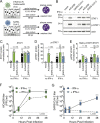Type I Interferon Susceptibility Distinguishes SARS-CoV-2 from SARS-CoV
- PMID: 32938761
- PMCID: PMC7654262
- DOI: 10.1128/JVI.01410-20
Type I Interferon Susceptibility Distinguishes SARS-CoV-2 from SARS-CoV
Abstract
SARS-CoV-2, a novel coronavirus (CoV) that causes COVID-19, has recently emerged causing an ongoing outbreak of viral pneumonia around the world. While distinct from SARS-CoV, both group 2B CoVs share similar genome organization, origins to bat CoVs, and an arsenal of immune antagonists. In this report, we evaluate type I interferon (IFN-I) sensitivity of SARS-CoV-2 relative to the original SARS-CoV. Our results indicate that while SARS-CoV-2 maintains similar viral replication to SARS-CoV, the novel CoV is much more sensitive to IFN-I. In Vero E6 and in Calu3 cells, SARS-CoV-2 is substantially attenuated in the context of IFN-I pretreatment, whereas SARS-CoV is not. In line with these findings, SARS-CoV-2 fails to counteract phosphorylation of STAT1 and expression of ISG proteins, while SARS-CoV is able to suppress both. Comparing SARS-CoV-2 and influenza A virus in human airway epithelial cultures, we observe the absence of IFN-I stimulation by SARS-CoV-2 alone but detect the failure to counteract STAT1 phosphorylation upon IFN-I pretreatment, resulting in near ablation of SARS-CoV-2 infection. Next, we evaluated IFN-I treatment postinfection and found that SARS-CoV-2 was sensitive even after establishing infection. Finally, we examined homology between SARS-CoV and SARS-CoV-2 in viral proteins shown to be interferon antagonists. The absence of an equivalent open reading frame 3b (ORF3b) and genetic differences versus ORF6 suggest that the two key IFN-I antagonists may not maintain equivalent function in SARS-CoV-2. Together, the results identify key differences in susceptibility to IFN-I responses between SARS-CoV and SARS-CoV-2 that may help inform disease progression, treatment options, and animal model development.IMPORTANCE With the ongoing outbreak of COVID-19, differences between SARS-CoV-2 and the original SARS-CoV could be leveraged to inform disease progression and eventual treatment options. In addition, these findings could have key implications for animal model development as well as further research into how SARS-CoV-2 modulates the type I IFN response early during infection.
Keywords: 2019-nCoV; COVID-19; IFN; SARS-CoV; SARS-CoV-2; coronavirus; interferon; type I interferon.
Copyright © 2020 American Society for Microbiology.
Figures





Update of
-
Type I interferon susceptibility distinguishes SARS-CoV-2 from SARS-CoV.bioRxiv [Preprint]. 2020 Jul 13:2020.03.07.982264. doi: 10.1101/2020.03.07.982264. bioRxiv. 2020. Update in: J Virol. 2020 Nov 9;94(23):e01410-20. doi: 10.1128/JVI.01410-20. PMID: 32511335 Free PMC article. Updated. Preprint.
References
-
- Gorbalenya AE, Baker SC, Baric RS, de Groot RJ, Drosten C, Gulyaeva AA, Haagmans BL, Lauber C, Leontovich AM, Neuman BW, Penzar D, Perlman S, Poon LLM, Samborskiy DV, Sidorov IA, Sola I, Ziebuhr J, Coronaviridae Study Group of the International Committee on Taxonomy of Viruses. 2020. The species SEVERE acute respiratory syndrome-related coronavirus: classifying 2019-nCoV and naming it SARS-CoV-2. Nat Microbiol 5:536–544. doi:10.1038/s41564-020-0695-z.. - DOI - PMC - PubMed
-
- Zhu N, Zhang D, Wang W, Li X, Yang B, Song J, Zhao X, Huang B, Shi W, Lu R, Niu P, Zhan F, Ma X, Wang D, Xu W, Wu G, Gao GF, Tan W, China Novel Coronavirus I Research Team. 2020. A novel coronavirus from patients with pneumonia in China, 2019. N Engl J Med 382:727–733. doi:10.1056/NEJMoa2001017. - DOI - PMC - PubMed
-
- Huang C, Wang Y, Li X, Ren L, Zhao J, Hu Y, Zhang L, Fan G, Xu J, Gu X, Cheng Z, Yu T, Xia J, Wei Y, Wu W, Xie X, Yin W, Li H, Liu M, Xiao Y, Gao H, Guo L, Xie J, Wang G, Jiang R, Gao Z, Jin Q, Wang J, Cao B. 2020. Clinical features of patients infected with 2019 novel coronavirus in Wuhan, China. Lancet 395:497–506. doi:10.1016/S0140-6736(20)30183-5. - DOI - PMC - PubMed
Publication types
MeSH terms
Substances
Grants and funding
LinkOut - more resources
Full Text Sources
Other Literature Sources
Molecular Biology Databases
Research Materials
Miscellaneous

